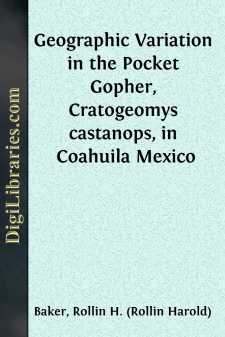Categories
- Antiques & Collectibles 13
- Architecture 36
- Art 48
- Bibles 22
- Biography & Autobiography 813
- Body, Mind & Spirit 142
- Business & Economics 28
- Children's Books 17
- Children's Fiction 14
- Computers 4
- Cooking 94
- Crafts & Hobbies 4
- Drama 346
- Education 46
- Family & Relationships 57
- Fiction 11829
- Games 19
- Gardening 17
- Health & Fitness 34
- History 1377
- House & Home 1
- Humor 147
- Juvenile Fiction 1873
- Juvenile Nonfiction 202
- Language Arts & Disciplines 88
- Law 16
- Literary Collections 686
- Literary Criticism 179
- Mathematics 13
- Medical 41
- Music 40
- Nature 179
- Non-Classifiable 1768
- Performing Arts 7
- Periodicals 1453
- Philosophy 64
- Photography 2
- Poetry 896
- Political Science 203
- Psychology 42
- Reference 154
- Religion 513
- Science 126
- Self-Help 84
- Social Science 81
- Sports & Recreation 34
- Study Aids 3
- Technology & Engineering 59
- Transportation 23
- Travel 463
- True Crime 29
Two New Moles (Genus Scalopus) from Mexico and Texas
Description:
Excerpt
In the spring of 1950, a field party from the University of Kansas Museum of Natural History including J. R. Alcorn, W. J. Schaldach, Jr., George Newton, and the author collected mammals in the Mexican state of Coahuila. A few days were spent in the Sierra del Carmen. One morning when examining sets for pocket gophers in these mountains, Alcorn found a mole caught in one of the traps. Subsequent examination discloses that this specimen belongs to a heretofore unknown species which may be named and described as follows:
Scalopus montanus new species
Type.—Male, adult, skin and skull plus body skeleton; no. 35668, Univ. Kansas Mus. Nat. Hist.; Club Sierra del Carmen, 2 mi. N and 6 mi. W Piedra Blanca, Coahuila, Mexico; 7 April 1950; obtained by J. R. Alcorn, original no. 11093.
Range.—Known only from the type locality; probably found in other localities in the Sierra del Carmen of northern Coahuila, Mexico.
Diagnosis.—Size medium and slender for the genus (see measurements); tail medium in length, sparsely covered with whitish hairs; claws of forefeet slender; upper parts near (h) Buffy Brown (capitalized color terms after Ridgway, Color Standards and Color Nomenclature, Washington, D. C., 1912), with slight rufous wash on top of head; underparts resemble upper parts but slightly paler with longitudinal band of near (14) Sudan Brown extending from chin posteriorly to and around base of tail, less intense on breast; skull small, arched, and relatively slender especially across mastoidal region; posterior part of cranium depressed; foramen magnum low when viewed from rear; external pterygoid region not greatly expanded; teeth small, especially upper third molar.
Comparison.—From Scalopus aquaticus, of which ten subspecies have been seen including those of significant geographic position, S. montanus differs in: Skull slenderer, less angular and relatively narrower across mastoidal region; cranium arched with hind part flattened; external pterygoid region less expanded; teeth relatively small, especially last upper molar. From S. inflatus, known to me from Jackson's description (N. Amer. Fauna, 38:53-54, pls. 2, 3, September 30, 1915), S. montanus differs in: Skull less angular and slenderer, prelachrymal region not inflated; zygomata slenderer.
Remarks.—S. montanus is known from a single specimen, which represents the second known occurrence of the genus Scalopus in Mexico. The other occurrence is that of S. inflatus in the state of Tamaulipas. S. montanus is geographically isolated in mountainous country from other species of Scalopus. Ten of the recognized subspecies of S. aquaticus were available for examination and descriptions of others were studied. It was found that the number and magnitude of the differences separating any one of these subspecies from an adjoining one was less than those separating S. montanus from S. a. texanus and S. a. intermedius, which are, geographically, closest to S. montanus. S. montanus seems not to be closely related to S. inflatus of Tamaulipas. S. montanus is given specific rank because of the great degree of difference between it and its nearest relatives, and because of its geographically isolated position.
The specimen of S. montanus was taken in a tunnel found by digging away a mound thought to be that of the pocket gopher, Thomomys sturgisi. A trap set in one direction in the tunnel caught the mole; a trap set in the other direction in the tunnel was later covered with soil, evidently by a gopher. After the capture a thorough inspection of the area revealed no "raised" tunnels, typical of Scalopus....









